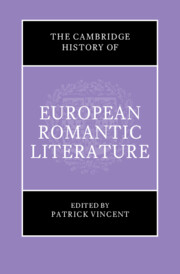Book contents
- The Cambridge History of European Romantic Literature
- The Cambridge History of European Romantic Literature
- Copyright page
- Contents
- Contributors
- Acknowledgements
- Note on the Text
- Chronology
- Introduction
- Part I Romantic Genealogies (1750–1790)
- Part II Revolution to Restoration (1790–1815)
- 7 Transcendental Revolutions
- 8 Citizens of the World
- 9 Romantic Loss, Emigration, and Exile
- 10 Women Writers’ Networks
- 11 Romantic Nationalisms
- 12 Shakespeare and Romantic Drama
- 13 Classics and Romantics
- Part III Restoration to Revolution (1815–1850)
- Further Reading
- Index
9 - Romantic Loss, Emigration, and Exile
from Part II - Revolution to Restoration (1790–1815)
Published online by Cambridge University Press: 10 January 2024
- The Cambridge History of European Romantic Literature
- The Cambridge History of European Romantic Literature
- Copyright page
- Contents
- Contributors
- Acknowledgements
- Note on the Text
- Chronology
- Introduction
- Part I Romantic Genealogies (1750–1790)
- Part II Revolution to Restoration (1790–1815)
- 7 Transcendental Revolutions
- 8 Citizens of the World
- 9 Romantic Loss, Emigration, and Exile
- 10 Women Writers’ Networks
- 11 Romantic Nationalisms
- 12 Shakespeare and Romantic Drama
- 13 Classics and Romantics
- Part III Restoration to Revolution (1815–1850)
- Further Reading
- Index
Summary
Chapter nine explores the phenomenon of historical dislocation and displacement in the Revolutionary and Napoleonic eras, focussing on early and later French Romanticism, but also drawing comparisons with other literatures. It shows how the Revolution’s effects extended throughout Europe, encouraging the circulation of people and texts. Opening with the soundscapes of Romanticism, the chapter moves on to aristocratic memoirs and autobiographies by celebrity exiles such as Chateaubriand but also little-known authors. It then develops the themes of errancy, melancholy, and death in prose and poetry, touching on works by Lamartine, Duras, Desbordes-Valmore, Vigny, Hugo, and others. Seth devotes particular attention to another famous writer in exile, Germaine de Staël. Making politics an integral part of literature, Staël and her circle spread their liberal ideas through their novels and essays, but also through translation, which contributed to the circulation of Romantic genres such as Gothic and historical fiction. The chapter concludes with a section on Waterloo, which marked the end of French hegemony, a historical loss mourned in poems and novels by Balzac and Stendhal, but that also opened the way for a sense of shared European identity.
Keywords
- Type
- Chapter
- Information
- The Cambridge History of European Romantic Literature , pp. 284 - 318Publisher: Cambridge University PressPrint publication year: 2023



